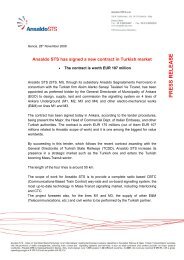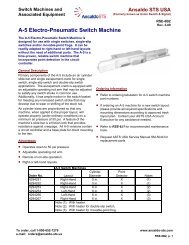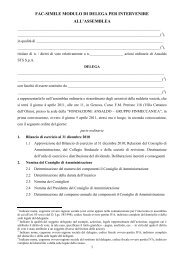You also want an ePaper? Increase the reach of your titles
YUMPU automatically turns print PDFs into web optimized ePapers that Google loves.
OperationA5 provides optical isolation of the four signals that may be sent to the Radio through four solidstate relays. The relays are controlled by the output section of the IN8.OUT8 PCB for the foursignals which are:East ClearEast Not ClearWest ClearWest Not ClearTwo outputs may be sent to the Radio simultaneously (one East and one West).A6 shows the interface between the Sleep Mode PCB and the MICROLOK II IN8.OUT8 PCB.Five Inputs to the IN8.OUT8 PCB (labeled A, B, C, D, and E) were previously described in A1,A2, and A3. The East/West Radio Wake-up is an input from A3. The East and West Auxiliaryinputs may be wired as shown in Figure 3-1 or to slide fence detectors, high water detectors,etc... These Auxiliary inputs must be "ON" in order to allow East Clear or West Clear signals tobe sent to the radio. The Restore Request Output and the Stay Awake Output is processed in A4,and the four Radio Outputs are handled in A5.The input signals to A7 consist of the Stay Awake signal and the four wake-up signals - EastTrack, West Track, East Radio/Test, and West Radio/Test. A7 contains the logic gatingnecessary to “OR” any of the four main flip-flops (the four wake-up signals) to the Power SupplyShutdown pin; the presence of any one of these signals will allow the MICROLOK II unit to turnon. The presence of the Stay Awake signal will keep the MICROLOK II unit up and running,even if the Master Reset signal is present, which would normally put the MICROLOK II unit inSleep mode. Also in A7 is the Sleep astable oscillator circuit which turns ON and OFF a frontpanel Sleep LED every three seconds, as long as none of the four main flip-flops are set.Five LED’s are located on the PCB front panel. These LED's are driven by the four wake-upsignals and the Test signal.4.2. Typical MICROLOK II Vital Sleep Mode Unit Operation4.2.1. General OverviewThe information contained in this manual pertains to a typical MICROLOK II Vital Sleep Modeunit. For instance, the radios used in this description do not have to be used. The radios areexternal to the MICROLOK II unit, as long as the Sleep Mode PCB sees a physical input, it willwork the same as it does in the following description. Remember that the following descriptionis not a mandatory setup of the MICROLOK II Vital Sleep Mode; it’s just a "typical example".The MICROLOK II Vital Sleep Mode is a user programmable broken rail detection system thatis intended for dark territory as an aid for improving operational movement in these areas.MICROLOK II units are placed at each end of a track circuit. For a Sleep Mode application,MICROLOK II units at each location normally operate in the power down or sleep mode,drawing very little battery power. MICROLOK II units can be awakened to a functional state in<strong>1D1.0032</strong>, Rev. 1, November 2010 <strong>SM</strong>6800B 4-3
















